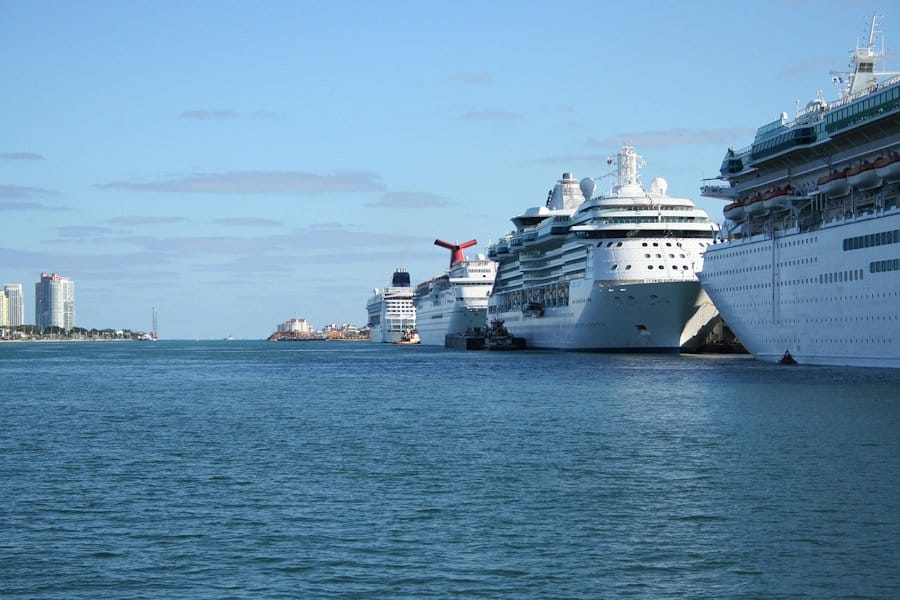Home » Where do cruise ship staff sleep?
Where do cruise ship staff sleep?
Updated October 13th, 2025
The officers, supervisors, staff and crew have a hierarchy depending on the job they are performing. For someone at the “bottom” of the hierarchy, their cabins are often small, and the space is shared, with little room for anything other than essentials.
Life Below Deck: Crew Accommodations on Cruise Ships
Cruise ships, often compared to floating resorts, offer luxurious staterooms for thousands of passengers.
However, the accommodations for the crew, who keep these vessels running smoothly, are less visible but equally essential.
Tucked away on lower decks, crew quarters prioritize functionality over luxury.
This article explores where crew members live, the design of their accommodations, the amenities provided, and how cruise lines support their workforce, shedding light on the vibrant communities that power the cruise experience.
Besides wondering where staff sleep, you may also wonder just how those same staff members Keep Cruise Passengers Fed?
Where Crew Quarters Are Located
Crew accommodations are typically situated on the lower decks, below passenger areas, in what is often called the crew deck.
These spaces are strategically placed near key work zones, such as the engine room, galleys, or housekeeping stations.
This proximity ensures crew members can quickly reach their posts, accommodating the demanding schedules of roles like waiters, cleaners, or engineers.
Unlike passenger cabins with ocean views, crew quarters are designed for efficiency, maximizing the ship’s limited space.
The crew deck is a restricted area, off-limits to passengers to maintain privacy and operational flow.
Soundproofing and reinforced walls help reduce noise and vibrations from machinery, creating a more restful environment.
On modern ships, like those operated by Royal Caribbean or Norwegian Cruise Line, crew areas may include small portholes or artificial lighting to mimic natural light, enhancing the living experience.
Design of Crew Cabins
Crew cabins are compact, built to prioritize practicality over luxury.
Most crew members, from servers to maintenance staff, share cabins with one to three roommates, depending on their role and seniority.
These cabins typically feature bunk beds to save space, a small desk for personal use, a private bathroom with a shower, and limited storage for clothing and belongings.
Wardrobes are narrow, and shelves are minimal, encouraging crew to pack light.
Higher-ranking officers, such as the captain, senior engineers, or department heads, often receive private cabins.
These may include a small sitting area, a larger desk, or even a double bed, offering more comfort. While not as lavish as passenger suites, these quarters provide a quiet retreat after long shifts.
Soundproofing and vibration-dampening materials are standard, especially on lower decks near the engine room, ensuring restful sleep despite the ship’s constant motion.
Amenities for Crew Comfort
Beyond sleeping quarters, cruise ships foster vibrant crew communities with dedicated facilities.
These amenities help maintain morale among the international workforce, which often includes members from dozens of countries. Common crew facilities include:
- Mess Hall: A dining area serving diverse cuisines to reflect the crew’s global backgrounds. Meals range from Filipino adobo to Indian curries, catering to varied tastes. The mess operates on a schedule aligned with crew shifts, ensuring access to fresh food.
- Gym: A small fitness center with treadmills, weights, and cardio equipment helps crew stay active during downtime. This is crucial for physical and mental health, given the demanding nature of their work.
- Crew Bar: A social hub where crew members can unwind with drinks, music, or games. The bar fosters camaraderie, offering a space to relax after long hours.
- Recreation Rooms: Modern ships, like those from Carnival or Princess Cruises, may include internet lounges, TV rooms, or game areas with activities like foosball or board games.
These facilities create a sense of community, encouraging cultural exchange among crew members from diverse regions, such as the Philippines, India, or Eastern Europe.
Events like karaoke nights or talent shows further strengthen bonds, making the crew deck a lively, supportive environment.
Improving Crew Well-Being
Cruise lines have increasingly prioritized crew well-being, recognizing that a happy workforce enhances guest experiences.
Newer ships feature improvements in crew accommodations, such as larger cabins, better ventilation, and access to natural light where feasible.
For example, some Royal Caribbean vessels have crew cabins with small windows, a rarity on older ships. Enhanced insulation reduces noise, and ergonomic furniture improves comfort.
Internet access is another focus. While passenger Wi-Fi is often pricey, cruise lines like Norwegian provide crew with dedicated internet lounges or discounted connectivity.
This allows staff to stay in touch with family, a vital factor for those spending months at sea. Some ships even offer mental health resources, such as onboard counselors or wellness programs, to support crew during long contracts.
The Crew’s Role and Schedule
Crew members work long hours, often 10 to 12 hours daily, with shifts tailored to their roles. Housekeepers start early to clean cabins, while galley staff prepare meals around the clock.
Engineers monitor systems 24/7, and entertainers rehearse for evening shows. Despite these demands, crew quarters and amenities are designed to maximize rest and recovery.
Cabins are cleaned regularly by housekeeping teams, ensuring a tidy environment. Crew members receive linens, towels, and toiletries, similar to passengers, though products are basic.
Shared bathrooms are kept hygienic, with frequent checks to maintain standards. These small touches help crew feel valued, supporting their ability to deliver exceptional service.
Cultural Diversity Below Deck
The crew deck is a melting pot of cultures, with staff from over 50 countries on many ships. This diversity creates a unique onboard community. Crew members share stories, traditions, and languages, fostering mutual respect.
For example, a Filipino waiter might teach a colleague from India a traditional dance, while a Ukrainian engineer shares recipes during a mess hall meal.
These interactions build a sense of family, crucial for crew members far from home for months at a time.
Cruise lines encourage this cultural exchange through events like international food nights or crew talent shows.
Such activities boost morale and create lasting memories, making the crew deck more than just a workplace but a home away from home.
Why Crew Quarters Matter to Passengers
Understanding crew accommodations adds depth to the cruise experience. The staff’s dedication, from serving meals to maintaining the ship, ensures passengers enjoy a seamless vacation.
Well-rested, supported crew members are better equipped to provide the exceptional service that defines cruising. For instance, a cheerful waiter or attentive housekeeper can elevate a guest’s experience, from a warm greeting at dinner to a perfectly made bed.
Passengers rarely see crew quarters, as these areas are restricted to maintain privacy and operational efficiency.
However, knowing about the crew’s living conditions highlights their hard work. Tipping, engaging politely, or acknowledging their efforts can show appreciation for the unseen labor that powers the ship.
Tips for Supporting Crew Members
Passengers can enhance the crew’s experience with small gestures:
- Show Gratitude: A kind word or thank-you note goes a long way. Many cruise lines, like Carnival, allow passengers to nominate standout crew members for recognition.
- Tip Generously: If gratuities aren’t included in your fare, consider tipping housekeeping, dining, or bar staff for excellent service.
- Respect Schedules: Avoid requesting non-urgent services during crew rest hours, typically late at night or early morning.
- Engage Respectfully: Learn crew members’ names and share brief, friendly conversations to brighten their day.
These actions foster a positive environment, benefiting both crew and passengers.
Sustainability and Crew Facilities
Modern cruise lines integrate sustainability into crew areas. Energy-efficient lighting and water-saving fixtures in crew cabins reduce the ship’s environmental footprint.
Some ships, like those from Princess Cruises, use recycled materials in crew furnishings. Waste management systems ensure crew dining and living areas adhere to the same eco-friendly standards as passenger zones, aligning with industry-wide sustainability goals.
The Verdict: A Hidden Community at Sea
Cruise ship crew quarters, though compact and practical, are vital to the vessel’s operation. Located on lower decks, these spaces provide rest and community for the diverse workforce powering the ship.
Shared cabins, mess halls, gyms, and crew bars create a supportive environment, while newer ships offer improved conditions like larger cabins and internet access. Passengers benefit from the crew’s dedication, which ensures luxurious experiences from dining to entertainment.
By understanding life below deck, travelers gain appreciation for the hard-working staff. Enjoy vibrant ports, onboard luxuries, and stunning ocean views, knowing the crew’s hidden community keeps the ship sailing smoothly.
RECENT POSTS

Discover the Cruise Ports of Eastern Canada & Quebec

Inside the Worst Cruise Lines: Lowest-Rated Ships and Why They Disappoint

Snorkeling in Cozumel: A Cruise Passenger’s Guide for Your Port Day

How to Make the Most of a Short Port Stop in Cozumel

Cruise Ship Ports in Florida

